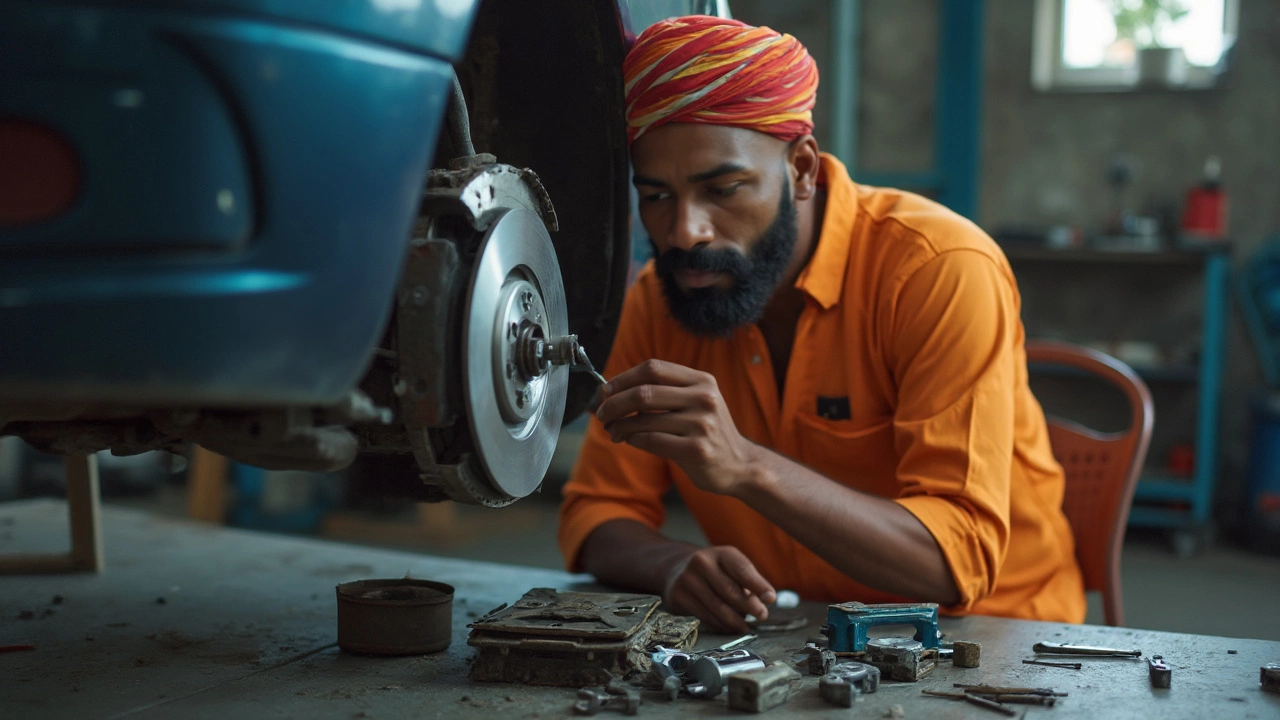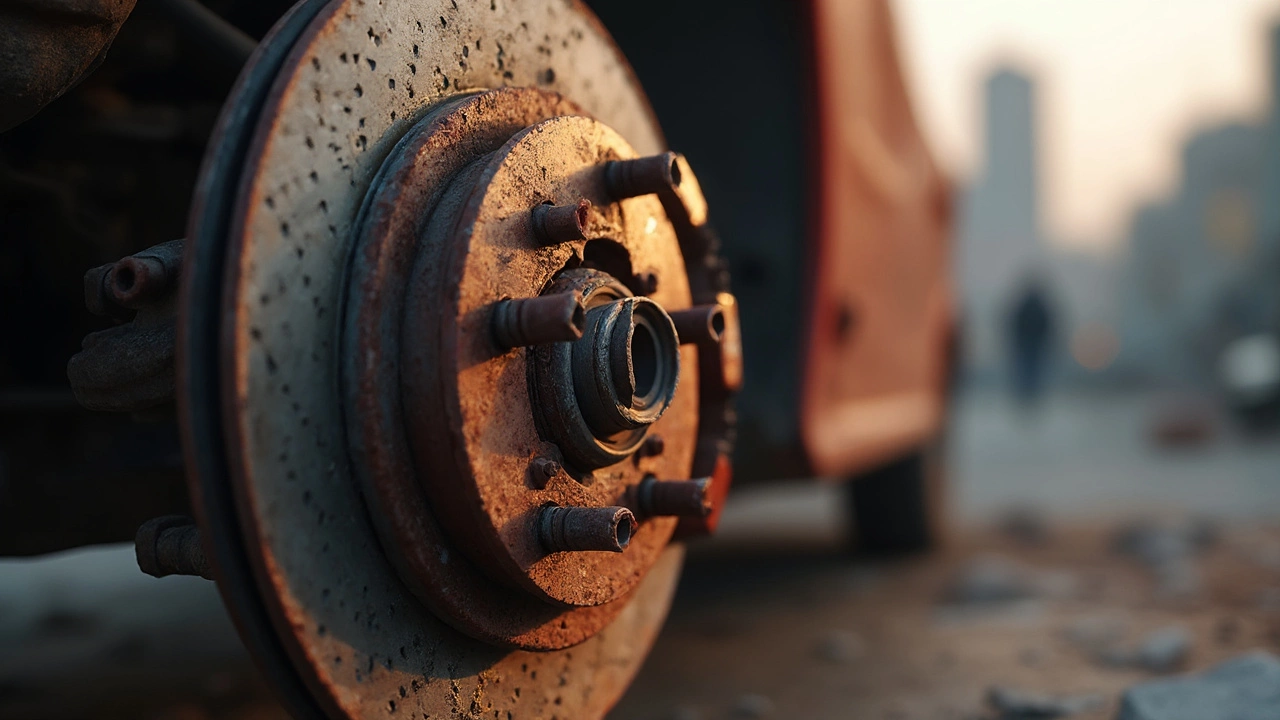 Apr, 4 2025
Apr, 4 2025
You ever find yourself pondering whether it’s cool to just swap out your car's brake pads and leave the rotors alone? It's a common question and totally worth asking. Let’s face it, car maintenance can get pricey, and cutting unnecessary expenses sounds tempting.
Before you grab those shiny new brake pads, you should know a bit about how your braking system works. Brake pads press against rotors to slow down your car, generating a ton of heat and friction. As a result, both parts wear down over time, but not always at the same rate.
Now, you might think about saving some cash by only changing the pads. Sometimes, that's perfectly fine—if the rotors aren’t too worn out or damaged. But how can you tell? Well, checking for deep grooves, warping, or uneven surfaces on the rotor can be the first step. If your rotors are smooth, you're probably good to go just with new pads.
- Understanding Brake Pads and Rotors
- When You Can Replace Just the Pads
- Signs Your Rotors Need Attention
- Tools and Steps for DIY Replacement
- Cost Implications and Savings
- Tips for Optimal Brake Health
Understanding Brake Pads and Rotors
Diving into the world of brake pads and rotors is like getting to know your car on a whole new level. These two components are the unsung heroes of your vehicle's braking system. The brake pads are the parts that actually make contact to stop the wheels, pressing against the rotors—the smooth steel discs bolted to the wheels.
So, what makes these brake rotors and pads such a dynamic duo? Well, each time you push the brake pedal, the pads clamp down on the rotors to create friction, slowing your car down. It’s this process that takes the heat, literally, in the form of energy that's gotta go somewhere. In fact, braking generates enough heat to keep your local pizza joint's oven running. Okay, maybe not, but it does get really, really hot.
Now, brake rotors come in various designs like plain, slotted, or drilled. Plain ones are your basic, cost-effective choice. Slotted and drilled rotors, on the other hand, help dissipate heat better, which is great if you drive a lot in hilly areas or enjoy a bit of spirited driving.
But here’s the rub: as the brake pads and rotors rub together, they wear down gradually. Over time, this wear can affect how well your car stops. Worn-out pads or grooved, warped rotors can lead to squeaky brakes or that unfortunate grinding sound nobody wants to hear.
- Plain Rotors: Budget-friendly, for everyday driving.
- Slotted and Drilled Rotors: Better heat dissipation, for high-performance driving or tough conditions.
Remember, keeping an eye on these components ensures your safety and others on the road. It's a simple yet crucial aspect of car maintenance that saves you both worry and money down the road.
When You Can Replace Just the Pads
Sometimes, your brake pads need a change, but your rotors might still be in decent shape. So, when is it okay to just switch out the pads and leave the rotors be? First up, it's all about how worn they are. If your rotors are smooth, without any deep grooves or scoring, replacing just the pads is usually fine.
A quick way to check is performing a visual inspection. If your rotors have a nice, smooth surface and aren't too thin, you're likely good. Just make sure they don't have any cracks or extreme rust.
- Inspect for deep grooves: Rotors shouldn't have visible impressions.
- Check rotor thickness: Most cars will have a minimum thickness listed in the owner's manual or shop manual.
- Feel for vibration: If your steering wheel or brake pedal vibrates when braking, that's often a rotor issue.
Per the experts, rotors can handle one or two pad changes before needing replacement themselves, depending on driving conditions and habits. Heavy braking and driving in stop-and-go traffic (like my rush hour drives in Hamilton) can wear them faster.
A study showed that regular highway driving where you don’t have to brake constantly prolongs rotor life. So, if you’re not doing much city driving, your rotors might last longer.
Just remember, every car and situation is different. Pay attention to how your vehicle feels during braking, and if in doubt, a quick chat with a mechanic can confirm if it’s smart to replace just the brake pads this time around.
Signs Your Rotors Need Attention
So, when should you start worrying about your brake rotors? Spotting the signs early can save you a lot of hassle down the road. Here’s what to look out for:
- Squealing or Squeaking Noises: If you hear weird noises when hitting the brakes, it might be time to check those rotors. It could be the pads, but if they’re new and the sound persists, the rotors could be uneven or too worn.
- Vibrations: Ever feel a vibrating sensation through your steering wheel or brake pedal? That’s a classic indicator of rotor trouble. Warped rotors can cause this shaky feeling, making your car less stable when stopping.
- Visible Damage: Take a look at your rotors for any visible grooves, gouges, or cracks. If they look more like an old vinyl record than a smooth surface, it's probably time for a closer inspection from a mechanic.
- Longer Stopping Distances: If it seems like your car needs more room to stop, worn rotors might be the culprit. They can reduce braking efficiency, making quick stops a bit risky.
A check-up can save you from a bigger repair job. Sometimes, rotors just need a little resurfacing instead of a full replacement. But ignoring these signs could mean bigger damage and even pricier fixes. Keep an eye out and take action if you spot any of these issues to keep your brakes working smoothly.

Tools and Steps for DIY Replacement
Ready to tackle replacing just the brake pads? It's not as daunting as it might seem, especially if you've got the right tools and a step-by-step plan. First up, let's gather the essentials you'll need for the job.
Tools You’ll Need:
- Jack and jack stands (to securely lift your vehicle)
- Wheel chocks (for extra safety)
- Socket set and wrench (to remove bolts)
- C-clamp or brake caliper tool (to compress the brake caliper piston)
- New brake pads (obviously!)
- Lug wrench (to take off the wheels)
- Torch or lamp (if you're working in a dim area)
- Brake cleaner (to clean components)
Now that you've got your tools, let's dive into the steps:
- Safety First: Park the car on a level surface. Make sure to engage the handbrake and stick wheel chocks behind the wheels that are going to stay on the ground.
- Get the Car Up: Use the jack to lift the vehicle and set it securely on jack stands.
- Remove the Wheels: Loosen the lug nuts using your lug wrench and take the wheels off.
- Access the Brake Pads: Remove the caliper bolts using the socket wrench. Carefully slide off the brake caliper and make sure it’s supported (don’t let it just dangle by the brake line!).
- Remove Old Pads: Slide out the worn-out brake pads. They should pop out fairly easily.
- Clean and Prep: Spray some brake cleaner on the caliper and surrounding area. This gets rid of dirt and brake dust—keeping things clean sets you up for a smoother installation.
- Insert New Pads: Slide in the new brake pads. Ensure they are sitting flush and correctly aligned.
- Compress the Piston: Use the C-clamp or a brake caliper tool to compress the caliper piston. This step is key to making room for the new, thicker brake pads.
- Reinstall the Caliper: Fit the caliper back over the brake pads and rotor, then secure it with the caliper bolts.
- Reattach the Wheels: Mount the wheels back on with the lug nuts and give them a good retighten once the car is back on the ground.
There you go! Replacing your brake pads without touching the rotors can be a simple task if done right. Take your time, follow each step carefully, and make sure everything feels snug and secure at the end. Safe driving!
Cost Implications and Savings
Thinking about just changing the brake pads? That's not a bad idea if you're tight on cash, but let's weigh some things out. On average, a basic brake pad replacement costs around $150 per axle, while swapping out both pads and rotors can reach up to $500. That's a decent chunk of change.
Why does this matter? Well, if your rotors are in good shape, sticking to a pad-only swap might be a smart move financially. However, it's crucial to consider the long-term. Spending now on both pads and rotors might prevent future headaches and bigger expenses.
According to Car and Driver, "Neglecting rotor replacement when needed can lead to reduced braking efficiency and increased wear on new pads."
If you're into keeping track, here's a simple table that lays out average costs:
| Service | Average Cost |
|---|---|
| Brake Pad Replacement Only | $150 - $200 per axle |
| Brake Pads and Rotors Replacement | $300 - $500 per axle |
So, how do you save the most? Before making your decision, inspect the condition of your rotors. If you're a DIY kind of person, check for grooves or warping. Noticed any? It’s probably best to replace them both.
And remember, cheap doesn’t always equate to good savings. Lower-cost pads might wear out faster or impact braking power, meaning you might land up spending more eventually. A smart choice can keep your wallet and your car happy.
Tips for Optimal Brake Health
Keeping your brakes in tip-top shape isn't just about safety—it's also about saving you some dough on future repairs. Let's chat about a few pointers to make sure your brake pads and rotors last longer and perform better.
First things first, don't underestimate the power of regular check-ups. Having a pro examine your brakes every 10,000-20,000 kilometers can catch issues before they snowball into bigger problems. You’ll want to replace your brake pads when they’re worn down to about 3-4mm to avoid rotor damage.
Next up, consider how you drive. Overloading your car, even with your beloved camping gear, can wear down brakes faster. Sudden stops, heavy braking, or riding the brakes downhill should be avoided if possible. Coasting and gentle braking can extend the life of your car maintenance parts like pads and rotors.
But it’s not just about what you do on the road. A little driveway maintenance can go a long way. Cleaning your brake components with a little DIY vinegar and water spray helps remove grime. This simple habit can help prolong the life of your braking system.
| Interval | Action |
|---|---|
| Every 10,000-20,000 km | Brake Inspection |
| Every 25,000-50,000 km | Possible Brake Pad Replacement |
| Every 50,000-70,000 km | Consider Rotor Replacement |
Finally, don’t ignore odd noises or vibrations when braking. Grinding sounds or pulsations often mean your rotors might need a check. Catching these early can prevent costly damage and repairs.
By following these straightforward tips, you’ll get the most out of your brake components, ensuring they’re reliable when you need them most.